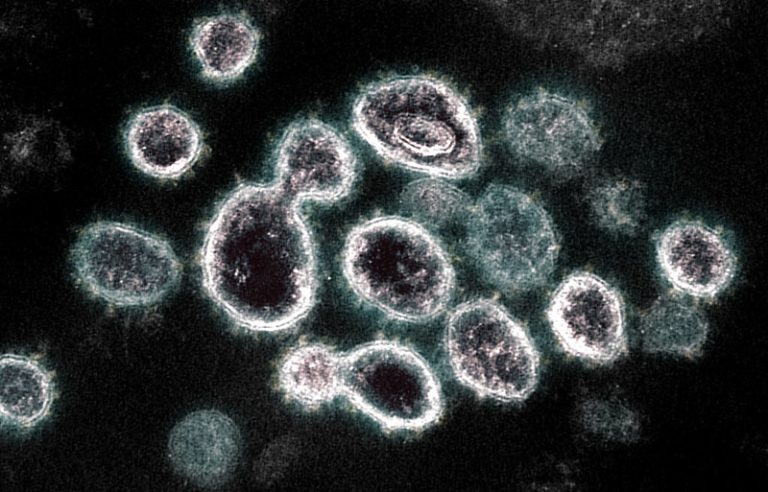News
“Gain of function” in viruses: research in question
Several techniques can be used to genetically manipulate viruses, for both medical and military purposes (known as dual techniques). Some would like to ban them, while others argue that science in this field should not be held back, so as to improve vaccines. What are the advantages and disadvantages of such manipulations? Is the freedom of researchers compatible with a ban?

A gain of function (GOF) is an action taken on a micro-organism to give it a new function. Similarly, loss of function is sometimes also sought using identical techniques. We will include this in GOF.
What does gain of function mean?
Let’s take an example. Suppose a virus is specific to an animal species and therefore unable to infect a human. A GOF, set up by a scientist, consists of growing this virus in a container with human cells and a suitable culture medium. Of course, a virus cannot reproduce if it cannot infect these cells. But viruses are never all identical. In fact, viruses have an enormous capacity for mutation. This is their selective advantage. It is therefore possible for a few viruses to infect a human cell, multiply there and go on to infect other human cells. These viruses then give rise to a population of viruses with a new function: the ability to infect human cells, and therefore to proliferate in the presence of human cells. The scientist can also cause the virus to lose its original ability (to infect the original animal species) in favour of another (to infect humans).
There are two main methods for producing GOFs. The first has just been described: it involves changing the environment, the artificial culture medium, to acquire a new function (and lose one). The second involves genetically modifying the virus, as is done with plants and animals, using various techniques and tools (meganucleases, CRISPR, etc.).
The example of SARS-CoV
For example, in 2015, the Wuhan laboratory (China) and the laboratory of R. Baric (North Carolina) co-authored an article in which they explained that they had changed the site (Receptor Binding Domain, RBD) of the spike protein of SARS-CoV (not SARS-Cov2!) so that it could infect humans1.
More specifically, they used a protocol known as “reverse genetics“. Using SARS-CoV genome sequences recorded on a computer, the researchers chemically synthesised a viral DNA molecule. This DNA molecule is a chimera combining the genetic sequence of a mouse (mammalian) SARS-CoV with the genetic sequence encoding a spike protein from a bat coronavirus. Using this molecule, the researchers produced chimeric viruses in cultured monkey cells. The chimeric viruses obtained were then tested on human cells (in particular a mammal) and the researchers observed their ability to infect these cells.
This research was partly funded by Peter Daszak’s EcoHealth Alliance. Why give these details? Because there is an ongoing debate, which has not yet been settled and which we won’t have time to address here, between those who believe that the disease is of zoonotic origin and those who believe that it originated from a leak from the Wuhan laboratory, specifically for SARS-Cov2. It was P. Daszak who collected American federal funds to finance research in Wuhan (including the research described in this article), even when American law prohibited such fundings on American soil2. This striking example justifies why research into gains in function is now a cause for concern in certain states of the United States of America and elsewhere in the world.
What are the drawbacks and risks?
Back in 1937, researchers found that the yellow fever virus cultivated on chicken embryo cells lost its ability to infect humans. Now, a virus that has been rendered inactive, when injected into a human, elicits an immune response. This is the principle behind inactivated agent vaccines. The process can be described as a GOF. A GOF is not necessarily harmful. But the techniques used to confer a new function are the same for making a vaccine or a biological weapon. These are known as dual techniques. The State can fund this research. At the very least, it can consider not funding it, limiting it or even banning it.
In fact, Texas has considered banning GOFs without pursuing the procedure. Florida voted for a ban in May 2023. But an article argues that this will have no impact, as no Florida researchers are affected3. The symbolic nature of a ban is not discussed. The same article points out that it is “unclear whether the Democratic Senate or President Joe Biden would approve” such legislative proposals, which often come from Republicans.
The US state of Wisconsin is also considering such a ban. Y. Kawaoka’s laboratory is located at the University of Wisconsin. In 2012, like R. Fouchier’s team, it explained how to increase the transmissibility of an H5N1 influenza virus between humans. In 2022, it emerged that numerous safety incidents had been reported in his laboratory. A committee of Republicans in the US Parliament asked him for explanations and “a long list of documents“4. This shocked the journal Science, which widely reported that a ban would limit the work of researchers5. This defence of researchers is supported, even if they are working on biological weapons or GOFs with the risk of laboratory leaks that could kill millions of people6. A ban “would significantly impede the ability of Wisconsin researchers to conduct research that is extremely important to the state” argued the University7. Is it really important for the state or for the researchers? The question is political. Shouldn’t (researchers’) freedom be restricted, at least in some cases?
Furthermore, it should be pointed out that the United States is a liberal society where only federal or state funding is discussed. Private (or military) funding is out of the question for them. The law stops at what the state funds, not what is done! In this liberal ideology, the state does not interfere in the private sphere, even if a private individual or company is developing biological weapons.
Research, whatever it takes?
A continuation of this debate deserves attention. Some people even want to ban the possession of the smallpox virus (in public laboratories!). Others object that they can resynthesise the virus using only the computer sequence (DSI) of its DNA. In 2018, Prof. Evans’ team demonstrated this possibility by synthesising the horsepox virus, which is especially large8. SARS-Cov2 has also been synthesised, following advances in synthetic biology9.
It is sometimes argued that virus cultivation would make it possible to see and accelerate mutations, and therefore to know what the next generation of viral diseases will be (influenza, COVID, etc)10. This is why P. Daszak boasted that he had “found numerous coronaviruses linked to SARS […], so there is a real potential for emergence“11. So, despite the withdrawal of some of his federal funding, he has continued to collect samples of viruses for his laboratories. But the next viral strain cannot be predicted. Evolution is not predictable. So mutating a virus is no guarantee of obtaining the future viruses that will appear in nature. The approach adopted is too simplistic.
We have seen that the development of these GOFs creates a danger. Those who want to ban them are accused of holding back science, and society is therefore called upon to say whether it accepts such dual research. There is no denying that a local ban will not be enough. But the difficulty of moving beyond a local agreement to a global one should not be an argument for doing nothing. At the very least, we can set an example.
- Menachery VD, et al, “SARS-like cluster of circulating bat coronaviruses shows potential for human emergence”, Nat Med, 2015 Dec;21(12):1508-13. ↩︎
- Annick BOSSU, “Covid-19 : un expert de l’OMS parle juste avant la pandémie”, Inf’OGM, 13 April 2021. ︎ ↩︎
- Kaiser, J., “Wisconsin bill to restrict pathogen studies worries scientists”, Science, 2024. ↩︎
- Congress of the United States, House of Representatives, Select Subcommittee on the Coronavirus Pandemic, Letter to Jennifer Mnookin, 1 September 2023. ︎ ↩︎
- Kaiser, J., “Wisconsin bill to restrict pathogen studies worries scientists”, Science, 2024. ︎ ↩︎
- Christophe NOISETTE, “Pathogens in the laboratory: absolute safety is an illusion”, Inf’OGM, 11 September 2021. ︎ ↩︎
- Kaiser, J., “Wisconsin bill to restrict pathogen studies worries scientists”, Science, 2024. ︎ ↩︎
- Noyce RS, Lederman S, Evans DH. “Construction of an infectious horsepox virus vaccine from chemically synthesized DNA fragments,“ PLoS One, 2018. ︎ ↩︎
- Xie, X. et al, “Engineering SARS-CoV-2 using a reverse genetic system”, Nat Protoc16, 1761-1784, 2021. ↩︎
- Burki T., “Ban on gain-of-function studies ends”, The Lancet, pp. 148-149, 2018. ︎ ↩︎
- Rebecca Robinson, “Covid expert discovers deadly new bat virus in remote Thai cave as pandemic fears soar”, Express, 16 January 2024. ︎ ↩︎








